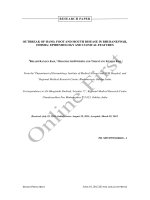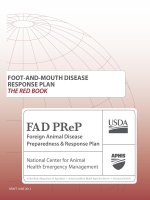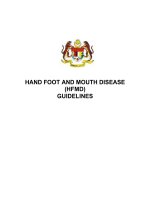Emergency appeal operation update Viet Nam: Hand, foot and mouth disease 11 May 2012 pdf
Bạn đang xem bản rút gọn của tài liệu. Xem và tải ngay bản đầy đủ của tài liệu tại đây (659.52 KB, 7 trang )
A trained Red Cross volunteer in Dong Thap conducts a focus group
discussion on how HFMD can be prevented among families with young
children in the community. Photo: Tran Sy Pha/National Disaster Response
Team, Viet Nam Red Cross
Emergency appeal n° MDRVN010
GLIDE n° EP-2012-000045-VNM
Operation update n°2
11 May 2012
Period covered by this operations update: 18 April to 7 May 2012
Appeal target (current): CHF 758,416
Appeal coverage: 28 per cent, with further funding currently in the pipeline.
Appeal history:
This emergency appeal was launched on 3 April 2012 for CHF 758,416 for nine months to assist 752,255
beneficiaries, including 196,200 direct beneficiaries.
Disaster Relief Emergency Fund (DREF): CHF 100,000 was allocated from the Federation’s DREF to
support the national society in its initial response to this emergency.
<click to see donor response, or contact details>
Summary
In the past month, the Viet Nam Red Cross
Society (VNRC) has prioritized eight
provinces to carry out rapid assessment
and a survey on the knowledge, attitude
and practice (KAP) of family members and
informal daycare givers on hand, foot and
mouth disease (HFMD). Arrangements for
activity starting in target provinces have
been implemented by VNRC while project
management structures at national,
provincial and district level are being
finalized. Priority activities and target
communes have been identified for
implementation of activity in the next
weeks, given confirmed resources for
emergency response.
The immediate start-up for the activities
was possible thanks to contributions to
this appeal from Canadian Red Cross,
Danish Red Cross/Danish government,
Japanese Red Cross Society, and
Swedish Red Cross.
To date, multilateral donors have confirmed a contribution of CHF 215,256. There is ongoing discussion with the
European Commission Humanitarian Aid and Civil Protection (DG ECHO) on funding the appeal. Discussion on
Emergency appeal operation update
Viet Nam: Hand, foot and mouth
disease
2
further funding with other partners and donors is currently in progress. On behalf of Viet Nam Red Cross, IFRC
would like to thank all partners and donors for their invaluable support of this operation.
The situation
HFMD showed no sign of reducing its incidence of infection across Viet Nam in April. An approximate 12,900
cases of HFMD, including seven confirmed fatalities were reported by the Viet Nam’s Ministry of Health. This
makes a total of 39,690 reported cases of HFMD, including 20 deaths from the beginning of the year. All fatalities
were children under five years of age who tested positive for EV71. In the week of 23-29 April, there were 3,493
HFMD cases reported in 61 provinces. There is an increase reported in this week in comparison to the week
before, which had a total of 3,100 new cases. The average of new cases weekly over the last four weeks is
similar to that of July 2011, which was the start of the second peak of HFMD in the country at the time.
Table 1: Update on HFMD cases in Viet Nam as of end-April 2012
Source: Viet Nam’s Ministry of Health, General Department of Preventive Medicines
By the end of April, there were 17 provinces reporting a sharp increase in new cases. The Ministry of Health
reported about 31,706 infected cases and 18 deaths caused by HFMD. HFMD cases have been reported in all 63
provinces in the country, while deaths occurred in ten provinces and particularly in the following provinces: An
Giang, Dong Thap, Dong Nai, Can Tho, Ho Chi Minh, Vinh Long, Da Nang, Binh Dinh, Ba Ria-Vung Tau, and
Dak Lak.
In the past month, it is noticed that for the first time the Northern provinces, particularly the provinces of Hai
Phong and Lao Cai have reported the highest number of new infections per region. In terms of fatalities, more
than 80 per cent of related deaths have occurred in the South since the beginning of the year.
As the spread of HFMD is believed to be more rampant during warm weather, health officials are gearing
themselves for an increase in cases as the summer season has begun. Officials from the Ministry of Health’s
General Department for Preventive Medicine (GDPM) have also said that controlling the HFMD outbreak
continues to be very challenging considering the combination of high population density and movement, and of
low level of hygiene practices among the general public, particularly caregivers of children under five. The
Ministry of Health also pointed out that while young children, particularly those under three years old are the most
vulnerable, adults actually are the virus carriers and pass on the disease.
Coordination and partnerships
In the past weeks, VNRC, with IFRC support, has focused on coordination with the Ministry of Health, and the
provincial health authorities in mapping out locations of Red Cross interventions as well as how communication
activities regarding HFMD can be coordinated at various levels, particularly at operational levels such as
provincial and district. Red Cross chapters have been working in coordination with district People’s Committee
and Preventive Health centres in determining the target groups and concerted inter-personal communication
activities. District selection for VNRC has been concluded with the agreement that there will be no duplication of
house-to-house visits and distribution of communication materials between VNRC and the provincial centres for
health communication and education of the target provinces.
Region
The first 17 weeks of 2012
Cases
Case/100,000
Deaths
Death/100,000
Death/case (%)
Whole country
39,690
44.3
20
0.02
0.05
North
18,047
45.3
0
-
0.00
Centre
5,836
49.6
3
0.03
0.05
South
14,160
41.9
16
0.05
0.11
Central Highland
1,647
40.2
1
0.02
0.06
3
At national level, situation updates and information sharing have been regularly shared between the Ministry of
Health with the VNRC headquarters. With support from IFRC, coordination between VNRC, WHO and UNICEF
has continued through meetings to share information and the status of each agency’s operation to respond to the
HFMD situation.
As a part of active fundraising work, IFRC has been engaging with donors in discussion on the appeal support. A
proposal application has been made to DG ECHO in the past week for final consideration. In addition, follow-up
with other contacted donors, including Red Cross Red Crescent Movement partners and diplomatic missions in
Viet Nam are being made.
National Society capacity building
The added value from the ongoing implementation of the HFDM operation to the long-term capacity for VNRC is
in its public health in emergency portfolio and response to the unprecedented increase of HFMD from the
beginning of 2012. This encompasses building overall community resilience and strengthening VNRC’s capacity
in reduction of the impact of HFMD in communities.
In the past week, it has been seen that VNRC has the capacity to engage community members in the knowledge,
attitude and practice (KAP) survey. The participation and data from community members’ perspectives will be
used to guide VNRC in its next steps in the operation, including the finalization of communication materials, and
the inclusion of tailored messages for inter-personal communication in training curricular for trainers and
volunteers for HFMD response.
By continued working with other stakeholders in-country on HFMD, VNRC capacity to work holistically and in
coordination with other stakeholders has been greatly expanded. This experience also contributes to raising
VNRC’s profile in response to health emergencies.
Red Cross and Red Crescent action
Overview
In the past weeks, a rapid assessment has been conducted in eight priority provinces including Soc Trang, An
Giang, Dong Thap, Long An, Vinh Long, Ben Tre, Quang Ngai and Da Nang for immediate response to HFMD.
The assessment contains key findings around target beneficiaries and the current response as well as existing
gaps; and proposed immediate actions to be taken. In the coming weeks, VNRC has prioritized response
activities in the following locations and the number of children to be reached as well as informal daycare centres
in the table below:
Table 2: Prioritized target beneficiaries in eight selected provinces as a result from rapid assessment by VNRC
Province
Target districts/cities
Total number of
target
communes
No. of beneficiary
children
under 5 years
No. of beneficiary
informal
daycare centres
An Giang
Phu Tan, Cho Moi
36
48,048
15
Dong Thap
Cao Lanh, Chau Thanh
30
28,208
13
Long An
Can Giuoc, Duc Hoa
37
31,885
145
Ben Tre
Ben Tre City, Mo Cay Nam,
Giong Trom
55
24,392
5
Vinh Long
Vung Liem, Long Ho
35
20,622
14
Soc Trang
My Tu, Ke Sach, Vinh Chau
33
34,479
5
Da Nang
Cam Le, Ngu Hanh Son, Hoa
Vang
21
25,606
202
Quang Ngai
Son Ha, Son Tinh, Quang Ngai
Town
45
31,662
190
TOTAL
292
244,902
589
4
Progress towards outcomes
Emergency health
Goal: Illness and deaths due to hand, foot and mouth disease (HFMD) in 13 priority affected provinces in
Viet Nam are reduced in the next six months.
Outcome: Target groups in 540 communes have improved knowledge and practices that lead to the
prevention and control of HFMD
Output 1. At least 196,200 people in 540 communes (30 districts from 13 provinces) have improved
knowledge and practices that contribute to HFMD prevention and control
Key activities
1.1. Update and broadcast key messages via national TV channels in six months
1.2. Disseminate TV clips to 13 chapters for further broadcasting and dissemination of key messages via
provincial radio and newspapers
1.3. Update key messages in existing IEC materials in consultation with MOH, WHO
1.4. Print and deliver 700,000 leaflets and 6,000 posters
1.5. Distribute 38,160 bars of soaps for 19,440 informal day-care centres and target beneficiaries at
campaigns in the first three months
1.6. Organize 30 public campaigns on HFMD prevention at district level
1.7. Conduct door-to-door visits to 90,000 beneficiary families in three months
1.8. Conduct 16,200 group sensitizations with mothers and members of families with children under five
years of age
1.9. Monitor behaviour change among target groups
Output 2. VNRC's capacity to respond to emerging diseases like HFMD is improved.
Key activities
2.1 Deploy national disaster response team (NDRT) to assist selected provinces with rapid assessment,
finalize provincial action plan, and support the implementation of knowledge, attitude and practices
(KAP) survey
2.2 Set up and maintain weekly and monthly reporting for district/provincial and headquarters project team
during this nine-month operation
2.3 Participate in relevant coordination meetings on HFMD prevention and emerging diseases at national,
provincial and district levels
2.4 Conduct baseline survey
2.5 Organize refresh training and training of trainers for 50 provincial instructors on HFMD
2.6 Update/train 5,400 selected commune volunteers on HFMD knowledge, community mobilization and
provision of adapted HFMD training, and visibility items.
2.7 Conduct an operations review to capture good practices and lessons learnt to inform VNRC
organizational strengthening in emergency health
2.8 Coordinate with the Ministry of Health and relevant partners to ensure continued alignment of the
operation with national efforts as well as to maximize complementary efforts.
Progress toward output 1:
Based on the concrete response from donor contributions to the appeal, VNRC has based its selection of the
eight priority provinces for immediate response in the coming weeks on the secondary data on infection and death
among the 13 target provinces. Priority is now set to cover 292 communes and 20 districts. In the next steps, the
scope of work will be considered in line with the available resources and capacity.
The project management structure at national headquarters and the eight target provinces has been identified. In
consultation with the Ministry of Health, WHO and UNICEF, a VNRC working group in charge of revising
communication materials at national level has reviewed the key messages in leaflets, posters and flipcharts which
will be used to conduct communication activities, as well as the training curriculum for trainers and volunteers.
Following the existing national guideline on risk communication in HFMD, studies on knowledge, attitude and
practice in hand washing, health-seeking behaviour from the World Bank and UNICEF, and technical assistance
5
from IFRC, VNRC has finalized a communication strategy that encompasses all communication
interventions/activities to be implemented within the framework of the operation.
With data gathered for children under five years and informal daycare centres in priority provinces, VNRC is able
to determine the exact scope of the intervention as well as ensure the interventions in those target districts will be
covering all at-risk children in the target district. With lessons learnt from last year’s operation, VNRC has been in
collaboration with the national and provincial health authorities in collecting statistics of HFMD cases in control
and non-control districts throughout the timeframe of the operation.
Progress toward output 2:
As a result of the rapid assessment, the national disaster response team (NDRT) has found out that in these eight
priority provinces, there have been a number of implemented and planned response activities in risk
communication and existing gaps. The table below presents key findings with regard to current response in the
selected districts.
Table 3: Table of locally implemented and planned activities in HFMD and the gaps
Province
Implemented communication
activities
Prevailing gaps
Planned communication
activities
An Giang,
Dong Thap,
Long An,
Ben Tre,
Vinh Long,
Soc Trang,
Da Nang,
Quang Ngai
Inter-personal
communication:
Implemented house-to-house
education for families in
outbreak locations by
Ministry of Health (MOH)
Held knowledge-sharing
events in HFMD prevention in
selected public pre schools by
MOH
Used communication
materials are leaflets, posters
that provided by MOH
Lacking of full coverage of all
children under 5 years of age in
the community.
Only one-time visit to
disseminate the key messages,
no follow-up on behaviour
change
No group interaction
Lack of communication
materials (leaflets, small posters
for households) for all families
with children under 5 years
Full coverage of house-to-
house visits by Red Cross
volunteers to all families
with children under 5 years
in target communes.
Full coverage of leaflets to
target households in target
communes
Follow-up visits to monitor
behaviour change in target
groups
Community mobilization:
Public campaigns in some
selected districts by People’s
Committee and MOH
Used communication
materials such as posters and
banners provided by MOH
Only a few districts with highest
infection cases are covered by
the campaigns.
Campaigns involve only a
limited number of community
members with strong focus on
using mass media, banners,
posters.
Focus on inter-commune
campaigns
Involve target groups,
community theatre groups
in campaigns
Focus on demonstration,
using songs, drama to
transmit the messages
Advocacy:
One combined meeting and
orientation for local
authorities and mass
organizations at district and
communal level in most
affected areas on HFMD was
provided by MOH.
No clear mechanism for
continuation of other sectors
and mass organizations in
coming activities
Units and staffs of VNRC in
charge of different levels
will continue to engage with
health, local authorities,
education sector and the
Women’s Union in different
activities.
Mass media:
Broadcast TV news, clips,
radio by MOH, media
TV clip is only broadcast for a
limited number of weeks.
Continue TV clips
broadcasting in the gap
months
6
VNRC will engage media to
further cover the issue
during the operation
Capacity building:
Training for health workers
and educators at district in
HFMD by MOH
Training does not reach
communal level while most of
the inter-personal
communication work will need
to be done at household level.
VNRC will select and train
10 volunteers in each
commune to cover house-
to-house visits in
communities.
After deployment of the NDRT to the eight priority provinces for rapid assessment and to assist chapters in
conducing the KAP survey, data from the survey questionnaires completed among informal daycare centres and
households with children under five years, have been collected. Data has been computerized with assistance of
an experienced national consultant who was involved in the last year’s KAP survey. Data processing and analysis
are being done at present and will be available shortly. The next step of the KAP survey is to incorporate findings
and recommendations in the finalization of communication materials, and the training-of-trainers and volunteers in
communication skills in HFMD, as outlined in the communications strategy.
VNRC has been working with the selected
chapters to facilitate information flow between
priority districts, chapters and the national
headquarters. The attention is to retain a weekly
reporting routine between levels to keep the
operation informed with facts and the situation of
HFMD in the community.
Continuing the good practice in cooperation with
the Pasteur Institute in the training-of-trainers
activity, VNRC will engage trainers from the
Institute in future trainer instruction sessions.
There will be two training courses for about 50
instructors who are active in the provincial and district health units. One of the courses will take three days to
refresh participant knowledge and includes a tailored element focusing on planning, monitoring, evaluation and
reporting (PMER). The other training-of-trainers course will be four days long and provide full sessions on specific
HFMD knowledge and facilitation skills. The master facilitators will consist of both trainers from the Pasteur
Institute and VNRC’s pool of master facilitators for community-based health and first aid.
Communications – advocacy and public information
In the past week, public communication on the HFMD situation and the Red Cross’ response in Viet Nam
continues in both national and international news. A follow up web story on IFRC’s website on 25 April to present
the primary findings of the NDRT’s assessment in the field as well as insights from community member
perspectives. The IFRC’s communication team also continues to engage with international media such as AFP,
Alertnet, and BBC, to provide periodic news on HFMD in Viet Nam.
From VNRC’s side, the national communication team also continues to actively engage with local media to inform
the general public about the HFMD situation, providing facts and key preventive messages. VNRC also
maximizes its communication channels via VNRC’s website and magazine to make information on HFMD in Viet
Nam available to the general public and highlighting Red Cross’s to the situation in the field.
Logistics
In the HFMD operation, VNRC will follow the standard procurement procedures for the purchase of soap,
communication and visibility items. A procurement committee will be mobilized to take charge of procurement and
Two trained Red Cross personnel interview care givers
in an informal day-care centre in Long An Province.
Photo: Quang Tuan, VNRC
7
make sure all requirements are met. The Federation country office will support VNRC in taking full charge of
implementing procurement procedures and will monitor the progress of this activity closely.
Contact information
For further information specifically related to this operation, please contact:
Viet Nam Red Cross
: Mr. Doan Van Thai, vice president, secretary general; phone: +84 913 216549
email:
IFRC country office, Viet Nam:
o Bhupinder Tomar, head of country office, phone +84 904 067 955,
email:
o Nuran Higgins, Operation Manager, phone +84 162 738 9827,
o email:
o
Ms. Thuan Nguyen, healthcare manager, phone +84 912 256 224,
email:
IFRC Southeast Asia regional office, Bangkok:
Anne Leclerc, head of regional office,
phone: +662 661 8201; email:
IFRC Asia Pacific zone office, Kuala Lumpur:
o
Al Panico, head of operations, phone: +603 9207 5700, email: :
o
Heikki Väätämöinen, operations coordinator, phone: +6012 2307895,
email:
o
Jim Catampongan, emergency health coordinator, phone: +603 9207 5779,
email:
o
Alan Bradbury, head of resource mobilization and PMER, phone: +603 9207 5775,
email:
Please send all pledges of funding to
Click to return to the title page
How we work
All IFRC assistance seeks to adhere to the Code of Conduct for the International Red Cross and Red Crescent
Movement and Non-Governmental Organizations (NGOs) in Disaster Relief and the Humanitarian Charter and
Minimum Standards in Disaster Response (Sphere) in delivering assistance to the most vulnerable.
IFRC’s vision is to inspire, encourage, facilitate and promote at all times all forms of humanitarian activities by
National Societies, with a view to preventing and alleviating human suffering, and thereby contributing to the
maintenance and promotion of human dignity and peace in the world.
IFRC’s work is guided by Strategy 2020 which puts forward three strategic aims:
1.
Save lives, protect livelihoods, and strengthen recovery from disaster and crises.
2.
Enable healthy and safe living.
3.
Promote social inclusion and a culture of non-violence and peace.









